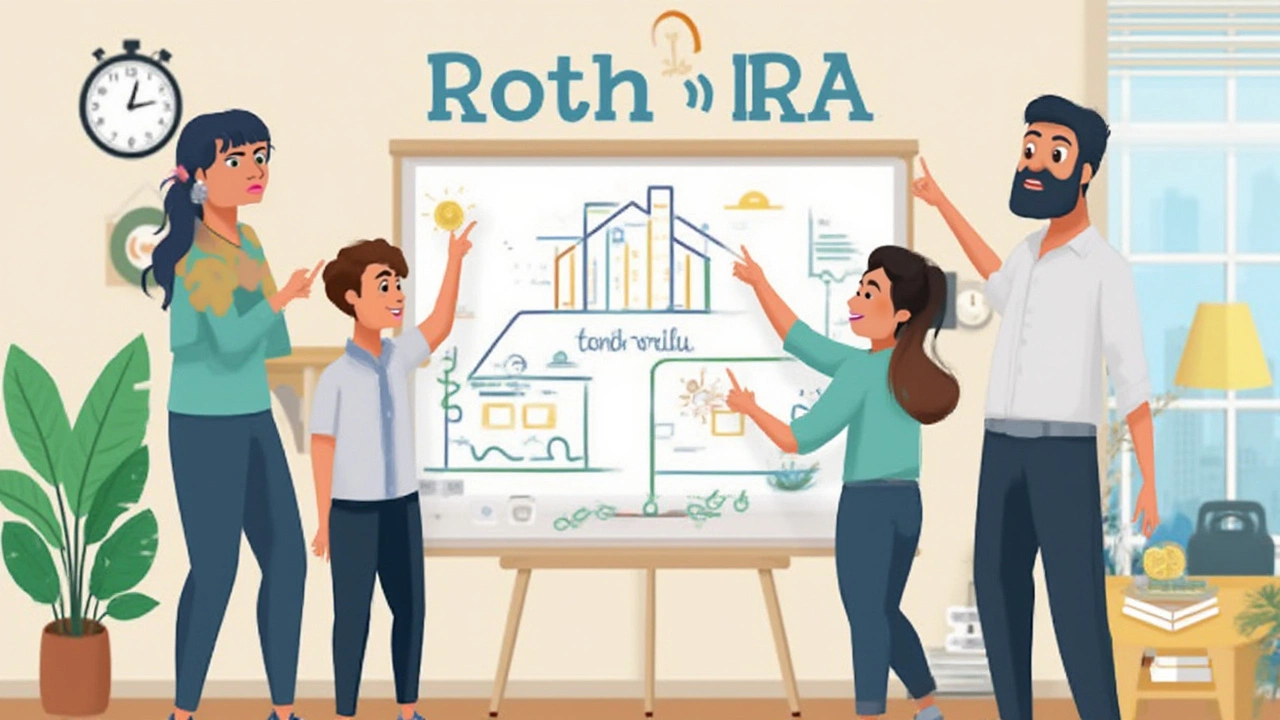Imagine you’re finally cashing in on your Roth IRA, only to get hit with surprise taxes. That’s not just bad luck—it’s often because people forget about the 5 year lifetime rule. This rule isn’t just a technical note buried in retirement account paperwork. For thousands of Americans trying to make smart moves with their money, it’s a detail that decides whether you’ll pay Uncle Sam or keep your cash where it belongs: in your own pocket. Maybe you’ve heard of it, maybe not. Either way, let’s break down how this one rule can make or break your long-term investment plans, and why knowing the real ins and outs gives you a serious edge.
What is the 5 Year Lifetime Rule and Why Does It Matter?
The 5 year lifetime rule is all about timing when it comes to withdrawing earnings from a Roth IRA or using certain types of real estate investments. Here’s the plain truth: If you want to take advantage of tax-free growth and withdrawal from your Roth IRA, you can’t just jump in whenever you want. Instead, you must wait at least five years after your first Roth IRA contribution, and you must be at least 59½ years old. It sounds straightforward, but there are plenty of hidden details and traps people stumble into. For example, that five-year timer starts ticking on January 1st of the tax year for your first contribution, not the exact date you put money in. So if you contribute on December 31st, 2020, your five-year period technically begins on January 1st, 2020—almost shaving a whole year off your wait.
So why does this matter? Because if you break the rule, the IRS can slap you with taxes and a 10% penalty on the earnings you withdraw. And you don’t want to get on the IRS’s bad side. Interestingly, this rule applies to every individual who opens a Roth IRA—not to each account (so if you have multiple Roth IRAs, it’s the date of your first contribution ever that sets the timer). That’s a mistake a lot of investors make, thinking the clock resets every time they open a new Roth IRA. Nope. Just once per person.
Here’s a quirky fact. Even if you rollover money from a traditional IRA to a Roth IRA—called a Roth conversion—the five-year rule pops up again, separately for each conversion. So if you did a conversion in 2021 and then another in 2022, you’d need to wait until 2026 and 2027 to get those particular dollars out tax-free. A "double dip" on the five-year clock, basically.
Many people confuse this rule with the overall "age 59½" rule for retirement accounts, but these two work together, not instead of each other. Skip the five-year rule, even if you’re 65, and boom—taxed. Meet the rule but you’re only 45? Also taxed. You need both. The five-year rule especially trips up people who get excited about moving old 401(k) money to a Roth IRA later in life. Picture a retired 60-year-old who converts $100,000 from a traditional IRA to a Roth. They need to wait until they’re 65 before they can withdraw those converted dollars penalty-free unless they tap into already-existing Roth dollars.
Much of this sounds like government bureaucracy at its finest, but there’s a method—at least for the IRS. The five-year rule exists to make sure Roth IRAs end up being true retirement accounts, not just quick and dirty tax-avoidance tools. "The point of the rule is to reward long-term savers, not people looking for easy loopholes," says Mark Luscombe, Principal Analyst at Wolters Kluwer Tax & Accounting in a
"The five-year rule for Roth IRAs is often a surprise for investors, but understanding it can be the difference between a tax-free windfall and a costly mistake."
You might also wonder why this applies to real estate investing. Here’s the twist—if you use a self-directed Roth IRA, you can invest directly in real estate. So, if you’re planning to flip houses or buy rental property inside your retirement account, ignoring the five-year clock could cost you thousands. Smart investors plan their timing, so money is ready and penalty-free right when they need it.

How the 5 Year Lifetime Rule Affects Different Investment Strategies
This rule isn’t just for people mindlessly setting aside money in index funds. If you’re investing in real estate, particularly through retirement accounts, the 5 year lifetime rule can shape your strategy in more ways than most people realize.
If you’ve never heard of a self-directed Roth IRA, you’re in for a treat—or maybe a headache if you don’t pay attention to the rules. These accounts let you invest in almost anything: single-family homes, apartment complexes, even raw land. The catch? Any profits made from property sales—inside this IRA—are only tax-free if you’ve hit both parts of the test: age 59½ and the five-year clock. If you mess up, taxes eat into your hard-earned real estate profits.
Let’s get specific. Pretend you bought a rental house inside your Roth IRA at age 55 and want to sell for a big gain when you turn 59½, thinking you’ve made it. But you only opened your Roth four years ago. Oops—the IRS will tax those profits if you didn’t start your account soon enough. This rule especially stings late bloomers, folks who discover the Roth IRA magic in their 50s and funnel money in at a fast pace, hoping to cash out soon. Some even get tripped up by rollovers. For example, anyone who does a Roth conversion to shield real estate sale profits must wait five years from each conversion, separate from their original contribution clock.
The five-year rule even pops up for inherited IRAs. Say you inherit a Roth IRA from a parent. If that account wasn’t open for five years before their death—even if they themselves were over age 59½—the withdrawal of earnings can still be taxable for you. Not exactly the inheritance most people are hoping for.
Here’s how the rule applies in concrete numbers:
| Scenario | Meets 5 Year Rule? | Tax on Withdrawal? |
|---|---|---|
| Contributed to Roth IRA in 2019, age 59½, withdrawing in 2025 | Yes | No |
| Contributed in 2022, age 65, withdrawing in 2025 | No | Yes |
| Converted traditional IRA in 2021, age 60, withdrawing in 2024 | No (for converted dollars) | Yes (on conversion earnings) |
Smart investors tie their withdrawal plans to their investment actions. If you’re buying real estate inside a Roth and expect to flip the property in two or three years, make sure you opened your Roth account early enough to avoid getting walloped by taxes. Real estate folks have seen big profits vanish because of poor timing — and it’s the easiest pitfall to avoid if you’re in the know.
This rule also plays a sneaky role for younger investors. If you open your Roth at age 18, by age 23 those funds are ready and waiting to be withdrawn tax-free (as long as you’re also 59½ when you take it out). Plus, the rule applies to ALL Roth IRAs, not just the one where you made the first deposit. Open a different Roth IRA with another broker, and your five-year rule still comes from your ORIGINAL Roth account, not the new one. Mess this up, and you could make a costly miscalculation in your plans.

Tips, Strategies, and Real-World Examples for Maximizing Benefits
Getting the most out of the five-year lifetime rule means thinking a few moves ahead. The trickiest part? Timing your first contribution or conversion, and knowing which clock (contribution or conversion) applies to your situation. Here are some field-tested tips and examples that show just how much of a difference smart planning makes.
- Start Your Clock Early: Even if you don’t have much money now, throw something—anything—into a Roth IRA as soon as possible. This plants your five-year flag and lets you unlock tax-free withdrawals far sooner than you expect. $100 today can mean thousands of tax-free dollars later.
- Keep Track of Conversion Rules: Every time you roll over money from a traditional IRA (a conversion), a NEW five-year clock starts on just those dollars. Make a spreadsheet or use an app to track these dates. Don’t just trust your memory.
- Withdraw Contributions Anytime: The 5 year rule only applies to earnings (the money you made), not your original contributions. You can always take out what you put in, tax- and penalty-free, even before age 59½. That’s a lifesaver if you’re in a pinch.
- Doublecheck When Rolling Over 401(k)s: If you’re converting a 401(k) or traditional IRA to a Roth late in your career, watch the conversion clock. Don’t plan on taking that money out tax-free immediately—even at retirement age—if your five-year window isn’t done.
- Use This Rule with Real Estate Inside a Roth: If you’re buying property through a self-directed Roth IRA, keep your investments and withdrawals planned around your five-year and age-59½ milestones. Missing this can turn a profitable flip into a tax-time flop.
- Inherited IRA Traps: Ask your estate planner or financial advisor if an inherited Roth IRA meets the five-year requirement. If not, you or your heirs could face extra taxes, even if the original account owner was over 59½.
A real-life example: Jake, a schoolteacher, started his Roth IRA in 2016 with just $500. When he inherited $50,000 from a relative in 2023, he rolled that money into another Roth IRA. Because he started his own Roth in 2016, by 2021 all his withdrawals became qualified if he was over age 59½. That meant when he retired, every penny could come out tax-free—including those big contributions and all the growth since then.
Stats highlight just how many people miss out. According to Fidelity’s 2024 Retirement Insights Report, nearly 37% of people with Roth IRAs can’t say exactly when their five-year clock started. That’s a whole lot of confusion—and missed opportunity—just for not paying attention to one simple rule.
If you’re a real estate investor using self-directed Roth IRAs, get connected with a savvy financial planner who knows these rules. Don’t just trust the random advice you find online. Bad info leads to IRS headaches down the road. With a little preparation, you can make these rules work for you, not against you. Think long-term, keep your timelines clear, and get every available dollar working in your favor when it comes time to retire or cash out a property investment.
Those who understand the five-year lifetime rule end up keeping more of their profits, paying less tax, and building a nest egg that actually stays theirs. The bottom line? It’s not the government’s rulebook that trips people up. It’s overlooking the details. Get familiar with the five-year clock, keep it front and center in your investment plan, and you’ll sidestep setbacks that catch plenty of folks off guard.





